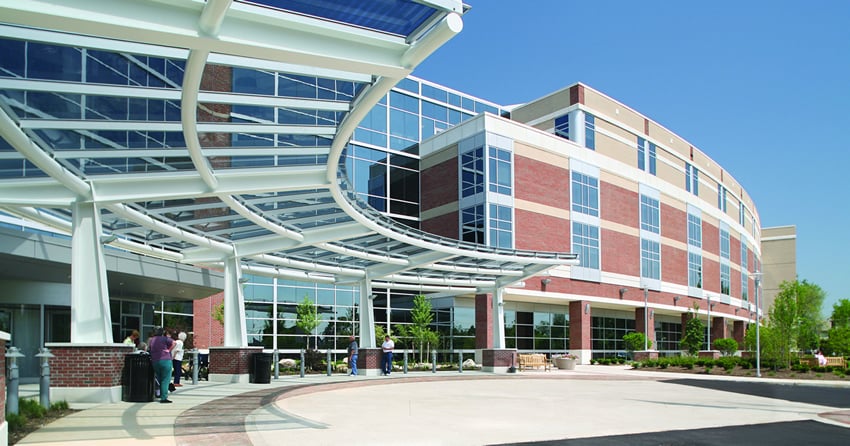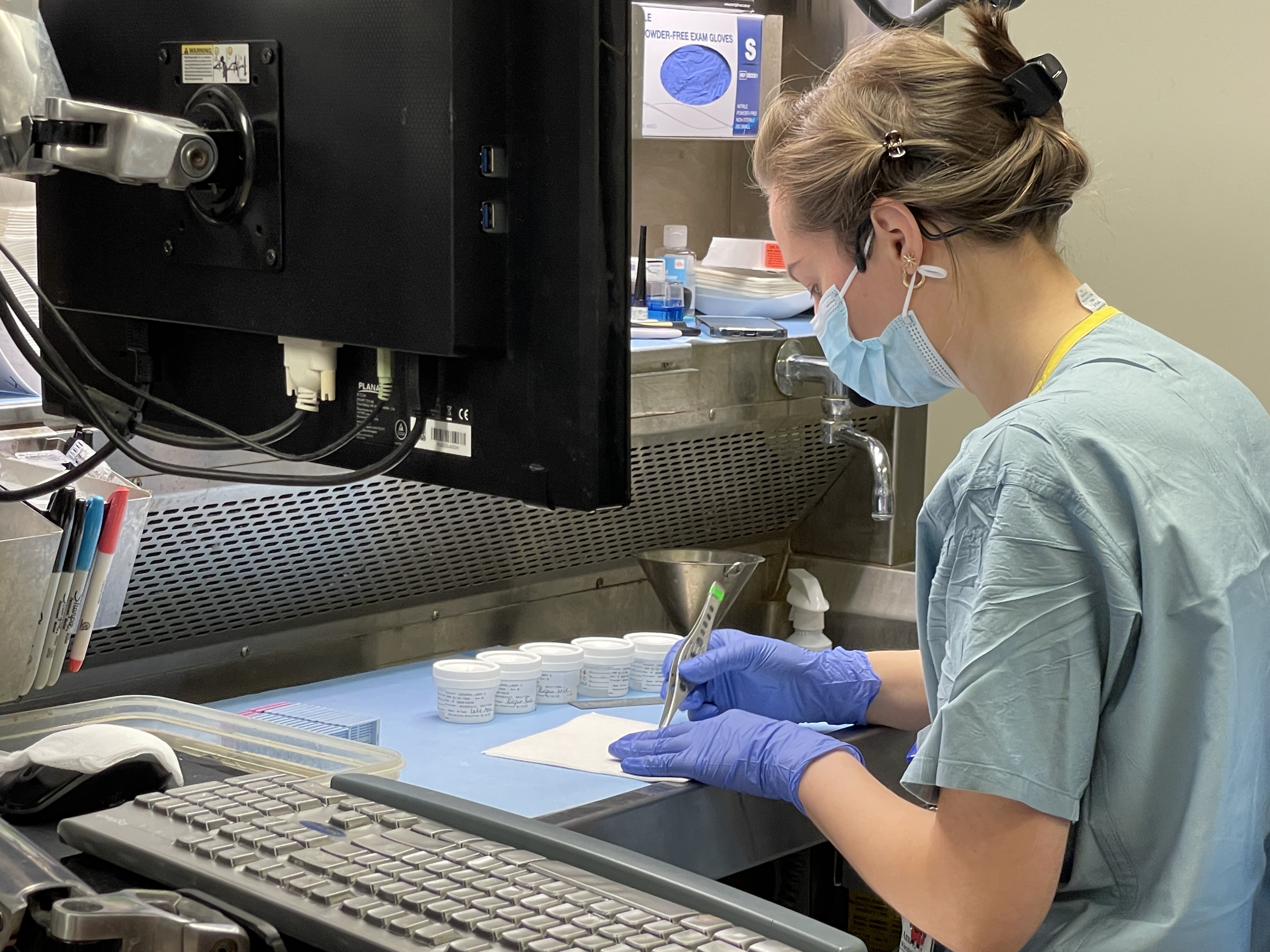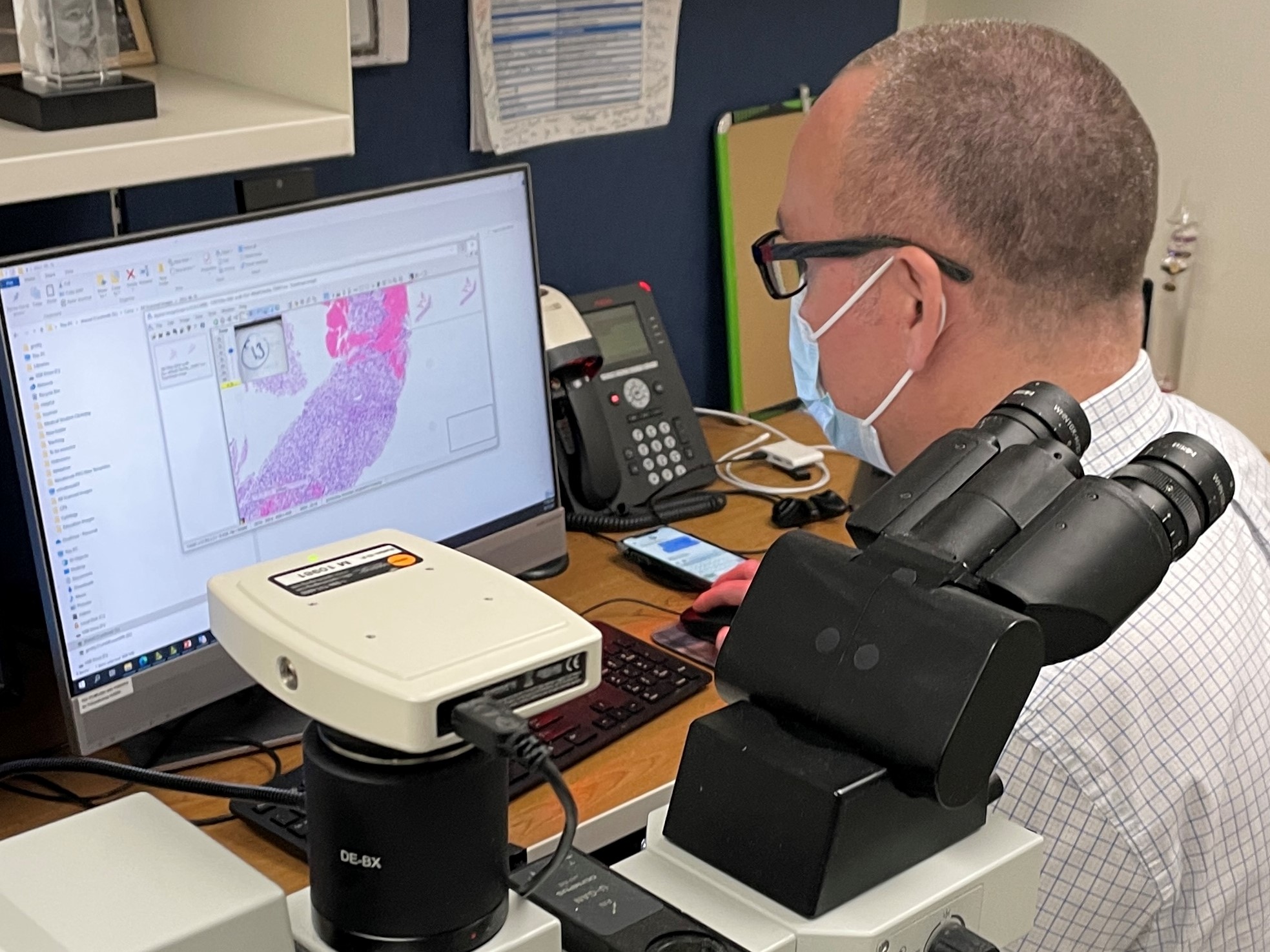- Case Study -
AULTMAN HOSPITAL SAVES MONEY, SAVES TIME, AND REDUCES ERRORS WITH VOICEOVER PRO

Pathologists Save Up to 45 Minutes Per Day, Thanks to VoiceOver PRO
At Aultman Hospital in Ohio, the anatomic pathology laboratory services four locations: Main Campus (Canton), Orrville, Alliance, and Pomerene; as well as a free-standing GI endoscopy center. The lab is on track to complete 21,000 accessions this year utilizing Cerner Millennium™ Pathnet as their laboratory information system (LIS).
The pathology department operates with three anatomic pathologists sharing the laboratory workload and completing signouts, with one additional pathologist who primarily signs out bone marrows and frozen sections. The lab also has a pathologist’s assistant (PA) who handles grossing.
One of the team’s pathologists, Dr. Pars Ravichandran, joined Aultman in June 2021. His previous institution had been a Voicebrook client and Dr. Ravichandran was one of their pilot users of VoiceOver PRO. “I was used to the convenience of PRO's reporting and templates and standardized reports,” says Dr. Ravichandran. “When I came here to Aultman, I was a little surprised that we hadn't implemented anything like PRO here."
.jpg?width=600&height=40&name=test1%20(2).jpg) CHALLENGES FACING AULTMAN HOSPITAL
CHALLENGES FACING AULTMAN HOSPITAL
Dr. Ravichandran notes several pain points that limited Aultman’s anatomic pathology laboratory.
NO ACCESS TO A SHARED LIBRARY OF TEMPLATES:
Aultman’s sole pathologists' assistant had been using the hospital-provided Dragon dictation and created his own templates. The pathologists would cover for the PA when he took his annual six-to-eight weeks of paid time off each year. Says Dr. Ravichandran: “When we covered the gross room for our PA, we were not comfortable using Dragon. First, the templates he created were saved under his own personal profile in Cerner. The Dragon templates you create there are not easily shareable. The setup there was not conducive for pathologists using voice recognition. So, when our PA was not here, we ended up doing gross work using Olympus Dictation -- an old-fashioned digital dictation station which is networked to the transcriptionists and they had to type long and elaborate gross descriptions.”
TRANSCRIPTION BOTTLENECKS:
All of Aultman’s pathologists were using the Olympus Dictation system and the transcriptionists were typing the reports. When Dr. Ravichandran started at Aultman, there were three transcriptionists. Two of those transcriptionists only worked three days a week.
“In addition to the main campus, we cover frozen sections and a couple other facilities. We have to pick up slides from outside facilities, and during operating room coverage for frozen sections or endobronchial procedures (which require a pathologist in the operating room) the timing is not in our control and they call anytime they need us,” Dr. Ravichandran states. “We have to go cover, then come back and resume our work. It puts us behind in finishing our slides."
"Typically, our slides start to come from 8:00 AM to 1:00 PM, and the slides that come late to us are often complex cancer resection cases, which we end up reviewing and composing our reports at the very end of the day. Sometimes the transcriptionists had to stay beyond 8:00 PM, well past their regular shift, to type the reports so we could get them ready for signout the next morning. It wasn't a good situation.”
LACK OF STANDARD PROCEDURE:
Dr. Ravichandran noticed that all three pathologists were doing their cancer synoptic reports in three completely different ways.
One pathologist had a binder of documents containing the commonly used cancer synoptic protocols printed off the College of American Pathologists (CAP) website. Says Dr. Ravichandran: “That binder was not being frequently updated. The secretaries didn't have the time to ensure that it was updated, and we weren't getting a notice from CAP notifying us to update or make changes. It was hard for a small institution like us to know when changes are made to the template.”
Another pathologist was checking the CAP website whenever a cancer case crossed their desk. They would log on to the CAP website and pull the most current template and read it off the screen into the dictation system. This meant that they were having to go through the entire template manually, reading off every detail word-for-word, including all of the template's sentences, questions, and answers. This made the dictation files for cancer cases very long and tiring for the transcriptionists to complete.
The third pathologist had their own approach. They tried to complete the cancer cases from memory. “In their mind , this pathologist knew what the standard order of the standard questions in the CAP checklists were,” says Dr. Ravichandran. “But there are a lot of items which are now essential, and sometimes the pathologist missed those. So this led to a situation in the latter half of 2021, where approximately 10 percent of our cancer synoptic reports were asked to be corrected for errors.”
REPORT ERRORS:
In the case of the pathologist who was recreating the CAP protocols from memory, the errors were discovered during the hospital’s cancer center certification inspection by the American College of Surgeons.
“When the inspectors were reviewing the reports for completeness and compliance with the cancer center accreditation requirements, they found that some reports were missing two essential data elements," Dr. Ravichandran says. "We had to correct them, and it takes a lot of time to go back to each case and correct those reports.”
"These core data elements were mandatory for purposes of accreditation, and the pathologist thought it was unnecessary to put in that data element because it didn't apply to the case. But they did not realize that from the cancer center's standpoint, it was a completely essential element."
TRANSCRIPTION ERRORS:
There were transcription errors as well, both because of dictation mistakes and transcriptionist errors.
“There was no instant way to know that you got something wrong,” Dr. Ravichandran recalls. “The next day when you look at it or late in the evening when you look at it, it's not always easy to catch those mistakes.”



“With VoiceOver PRO, we finish our workload 30 to 45 minutes earlier, on average. This is due to instant report creation by dictation and immediate sign out. At the end of a busy day, that time savings is a huge difference maker for us.”
THE SOLUTION: VOICEOVER PRO
About three months into Dr. Ravichandran’s time at Aultman, he contacted the physician in charge of IT and said the pathology department needed a system to help them improve their reporting. At that time, Ravichandran says, the hospital wanted them to try mTuitive. “But my problem with that was mTuitive does not offer full dictation capability,” Dr. Ravichandran explains. “It does help with synoptic reporting for cancer cases, which is like six or seven cases a day we sign out. But it wouldn't help with all of the routine report generation work, which we needed because we basically wanted a full voice recognition reporting system for all of our pathology reports for consistency. So mTuitive simply wasn't capable.”
It took more than six months of back and forth, with hospital IT leadership asking the pathology team to move completely to voice-recognized dictation. Dr. Ravichandran kept explaining that the Dragon system that Aultman provided was "not capable of the multi-part formatting of the typical pathology workload, as well as the cancer synoptic reports."
Once the team saw a demo of VoiceOver PRO in action, the pathologists quickly threw their support behind PRO. It took a few more months for hospital administrators to sign off on the deal, pressured by the imminent retirement of one of their transcriptionists. “We wanted to be sure that we were prepared for any eventuality where we may not have much transcription support,” Dr. Ravichandran says.
 IMPLEMENTATION OF VOICEOVER PRO
IMPLEMENTATION OF VOICEOVER PRO
FROM KICKOFF TO GO LIVE IN JUST FOUR MONTHS
The VoiceOver PRO project kickoff commenced at Aultman in August 2022. It took only four months for the pathology lab to go live in December 2022, in VoiceOver PRO's hosted environment.
The hosted VoiceOver PRO architecture is a centralized configuration in which the VoiceOver PRO Windows desktop software connects to a web-hosted database via the use of a shared set of services that live in Microsoft Azure (a cloud computing service). This allows for usage of the PRO application from any workstation. Utilizing a hosted back-end allows the laboratory to quickly utilize the benefits of PRO, without the need for a massive up-front IT investment.
“The Voicebrook team has been very attentive,” says Allyson Blake, laboratory manager of Aultman’s Canton campus. “Their project management was very good. Everything stayed on track and the support they provide to the pathologist is great. If I have any questions or need anything Voicebrook has been really good at getting back to me and keeping me updated, which I really appreciate.”
Voicebrook sent a three-person team to visit Aultman Hospital during the project kickoff, where they sat with each pathologist to observe their workflows. “In September we had some data gathering and starting in October we had a version of the PRO product available for use,” says Dr. Ravichandran. “And while using it on the fly, we kept changing and got it to work the way we wanted. We had two additional visits by the Voicebrook implementation team prior to the go live date. And during go live, Voicebrook was here to troubleshoot on the spot.”
Blake was impressed with how quickly the pathologists were able to learn the system and implement it. “They're very smart people and really great doctors,” Blake says. “But I do know that sometimes they don't mix well with technology, because there was other technology that we've tried to implement previously and it has been a rougher process. I was impressed with PRO because it was very smooth and all the issues were addressed in a timely manner. The staff has been really happy with the system."
VOICEOVER PRO SOLVES A CRISIS -- BEFORE EVEN GOING LIVE
In fact, the implementation went so well that Dr. Ravichandran was able to sign out more than 75 cases before PRO went live at Aultman.
It happened out of necessity, when their PA was off and one of the doctors was covering the gross room. This made the transcriptionist's workload explode, because they had to finish the gross description and also type up the final diagnosis reports. “She was the only transcriptionist available that week,” Dr. Ravichandran explains. “We had a crisis on our hands. I thought, let me just use PRO. I used PRO exclusively, because for the simple reports it works perfectly, and the cancer checklists are already something you pass through CAP so I knew it would work well.”
The other three lab staff had not extensively used voice recognition, yet they adapted very quickly to VoiceOver PRO. Dr. Ravichandran was particularly surprised at how well his colleague Dr. Morgan did with learning the system. "He didn’t have any prior experience. A couple of weeks later, he said that he liked PRO very much and told me, ‘I cannot go back to regular dictation now.’”
"We were able to eliminate two transcription positions by automating the process completely with PRO. That’s huge, because with staffing shortages we were able to take those positions and transition them elsewhere."
THE RESULTS
MAJOR EFFICIENCY IMPROVEMENTS WITH PRO
Not only is VoiceOver PRO improving the ease of Aultman's pathology workflows, the efficiency improvements are massive.
“We finish our workload about 30 to 45 minutes earlier, on average,” Dr. Ravichandran says. “This is due to instant report creation by dictation and immediate sign out. Previously we had to wait until the end of the day to let the transcriptionists finish their work and then sign out the reports in the late evening. At the end of a busy day, that time savings is a huge difference maker for us.”
The moment Dr. Ravichandran completes a report, he sees the report transferred over into Cerner, verifies that it looks good, and immediately releases the report. “Getting a report out faster, even a few hours per case, can make a big difference in patient care. Typically our doctors prefer to do their rounds on the floors and the wards in the morning,” he says. “With PRO, as soon as you complete the diagnosis of the cancer or a biopsy specimen, the results are instantly released into Cerner. When they do the rounding at 6:30 or 7:00 in the morning, the clinicians already have the complete result on their screens.”
SHORT-STAFFED? NO PROBLEM
In January, the lab was once again short-staffed and the volume of cases ramped up. So Dr. Ravichandran came to work on a Saturday morning and was able to dictate in his office, with no disruption, and finish all the cases. He says that flexibility would not have been possible if they did not have PRO. “With PRO, you could come late in the day or at a convenient time and take a break, come back to the slides and do a careful review and dictate at your own pace and control your own workflow.”
SAVING MONEY WITH AUTOMATION
The efficiency gains were so significant that Aultman Hospital was able to eliminate two transcription positions in the lab and automate the process completely with PRO. “That’s huge, because with staffing shortages we were able to take those positions and transition them elsewhere,” says lab director Blake. “We didn't get rid of the transcriptionists, but we're now using them for something else in a different area of the department. With case volumes going up and for some of our technologically-advanced positions, being able to use these lower-level positions to really help with the workload is great.”
PRO TEMPLATES OFFER EFFICIENCY AND FREEDOM
PRO's CAP checklists and custom templates have made the lab's reporting processes faster. Dr. Ravichandran anticipates even more time will be saved as they go forward, due to reduced need for correcting reports caused by missing CAP data elements.
Although their LIS (Cerner) is capable of allowing them to create templates, Aultman’s IT department did not give the pathologists the freedom to instantly create their own templates inside of Cerner. Instead, the process involved putting in a formal IT request for a template. Because the IT department is also facing staff shortages and a tremendous amount of workload, they would get to it when they could, and it took a lot of time and expense for them to complete a request to create templates as quickly as the lab needed them. “So when we set up PRO, I was amazed that we could create our own custom templates in PRO and they are shareable,” Dr. Ravichandran says. “We've already created some templates. And in addition to cancer, we are now creating templates on non-cancer reports that have multiple data elements. I think this freedom to create templates on PRO and move them over to Cerner is enormously helpful for us to further improve the process.”
PRO PROVIDES CONSISTENCY AND ELIMINATES ERRORS
When Aultman worked with Voicebrook on the customization process, pathology staff requested specific formatting elements like indentation and bolding in their reports in order to improve consistency.
Aultman’s cancer center coordinators have told the pathology department that they very much appreciate the consistent formatting, compared to previously where all three pathologists' cancer checklists were all slightly different. Now the reports have standardized formatting, resulting in a uniform flow of information from top to bottom in the report. Clinicians know exactly where to look when they're seeking an essential piece of data.
NO MORE MISTAKES
Remember those formatting errors that plagued Aultman with their cancer center certification? No longer a concern. “Those inspectors go line-by-line, saying ‘this is essential’ and ‘your report is missing this item’,” Dr. Ravichandran recalls. “They randomly review 20 or 30 percent of our reports, so if an incomplete report gets into their hands, you will hear about that in the summation meeting. But now, PRO prevents those errors. We like that when you try to move a report over to Cerner without completing an important element, PRO tells us that we are missing certain elements and prompts us to correct them. That automatic check helps us.”
Dr. Ravichandran used to worry and wonder if he was using the correct and up-to-date CAP electronic Cancer Protocols (eCP). “That worry is now gone. I can now be assured that what always passes through to me from PRO is going to be the latest updated version. That concern is not there anymore.”
Schedule your free VoiceOver PRO demo today!